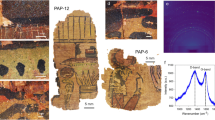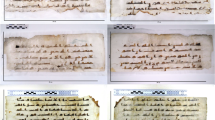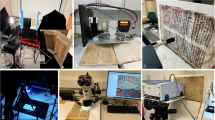Abstract
FUNERAL texts written on stones found inside a grave in the cemetery at Qumran have recently been described1. This discovery necessitated an investigation of the composition of the inks used by the Qumran community, chiefly because the ink on the stones had faded and could only be seen with the aid of ultraviolet fluorescent lamps, while photographs taken with ultraviolet lighting and infrared film were not satisfactory.
This is a preview of subscription content, access via your institution
Access options
Subscribe to this journal
Receive 51 print issues and online access
$199.00 per year
only $3.90 per issue
Buy this article
- Purchase on SpringerLink
- Instant access to full article PDF
Prices may be subject to local taxes which are calculated during checkout
Similar content being viewed by others
References
Steckoll, S. H., Revue de Qumran, No. 23, 323 (1968).
Plenderleith, H. J., Trans. Victoria Inst., 82, 146 (1950).
Plenderleith, H. J., in Barthelemy, D., and Millik, J. T., Discoveries in the Judaean Desert, I, Qumran Cave I, 39 (Clarendon Press, Oxford, 1955).
Avigad, N., and Yadin, Y., A Genesis Apocryphon, 13 (Magnes Press, Jerusalem, 1956).
Lucas, A., The Analyst, 47, 13 (1922).
Forbes, R. J., Studies in Ancient Technology, 3, 230 (Leiden, 1955).
Baillet, M., Millik, J. T., and de Vaux, R., Discoveries in the Judaean Desert, 3, 70 (Clarendon Press, Oxford, 1962).
Author information
Authors and Affiliations
Rights and permissions
About this article
Cite this article
STECKOLL, S. Investigations of the Inks used in Writing the Dead Sea Scrolls. Nature 220, 91–92 (1968). https://doi.org/10.1038/220091b0
Received:
Revised:
Issue date:
DOI: https://doi.org/10.1038/220091b0



